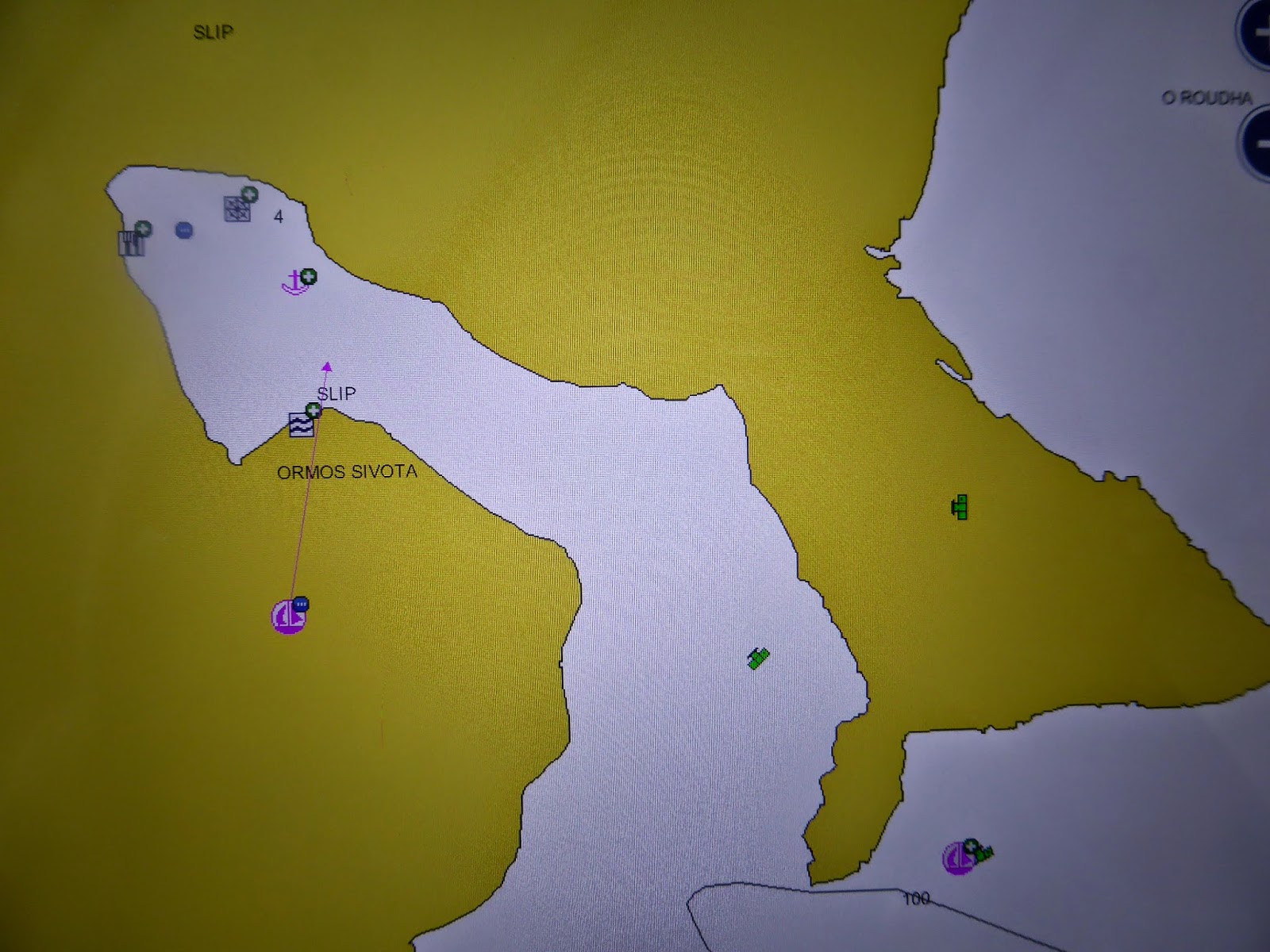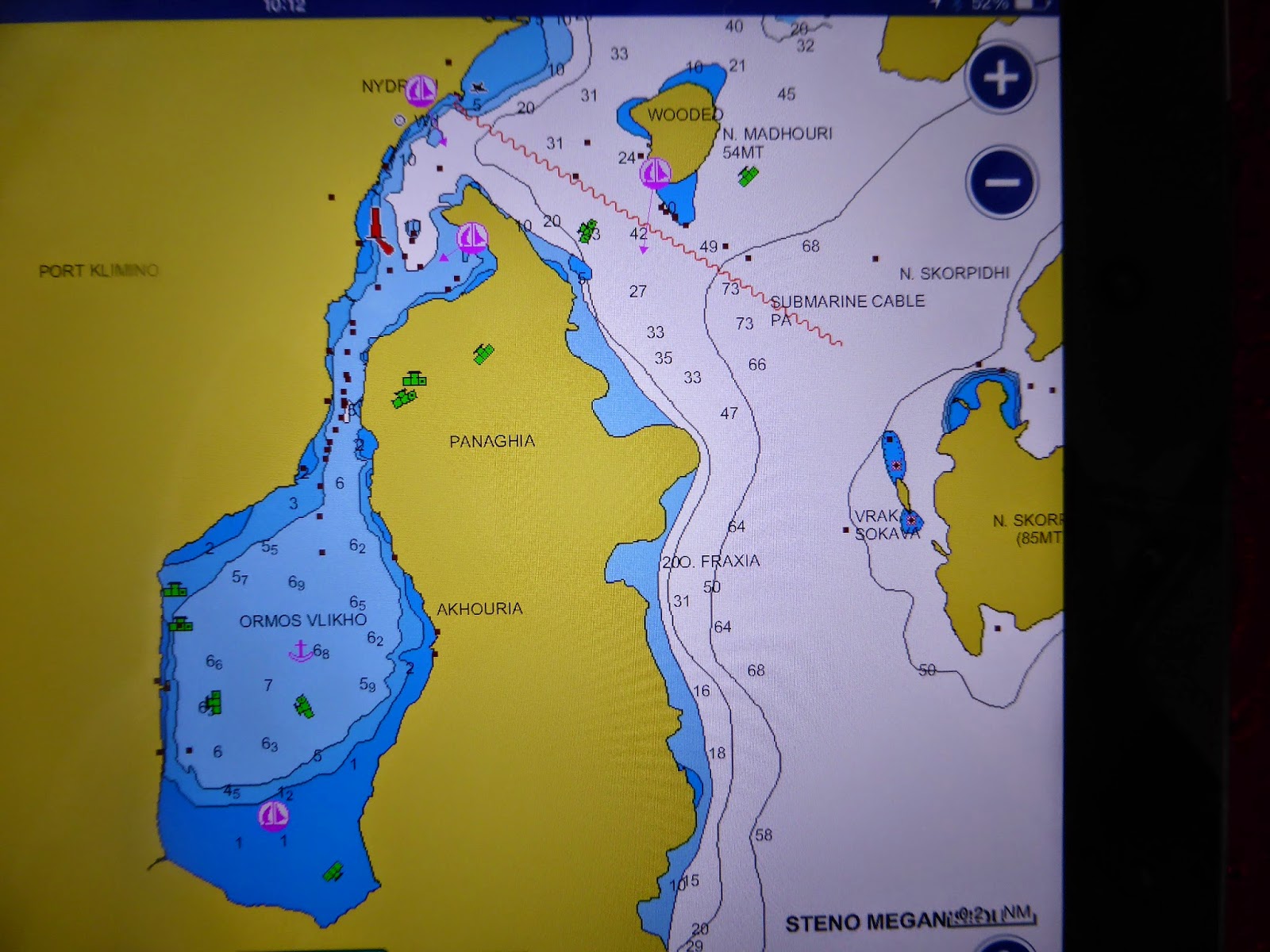Envoy is currently in Lefkas marina for the Med winter.
With our washing machine working well we finally leave Gouvia Marina and spend six days cruising south, stopping at some of our favourite anchorages – Mourtos on the mainland, Lakka on Paxoi Island, Ormos Vlikho and Sivota on Lefkas Island and Fiskardho on Cephalonia.
We’ve started including more maps on the Blog as we think boating people would like to see what type of shelter is offered by some of the places we mention. These anchorages are far more protected than we found in Sicily.
Map of Lakka
Sivota is a great bay with excellent shelter
Map of Sivota
Then we get another bad forecast – heavy rain, thunderstorms and winds to 30 knots, so head into Ormos Vlikho to sit this out. Ormos Vlikho is a perfectly sheltered bay, a little under a mile wide, about seven metres deep with good holding and no swell. But it’s surrounded by high hills and subject to katabatic gusts – it is here that a 12 metre catamaran was capsized at anchor by strong winds several years ago. So we sit out three days of rain, thunderstorms and winds up to 34 knots.
Map of Ormos Vlikho
In the NW corner of Ormos Vlikho several wrecks are grounded - note heavy cloud cover
Our last couple of days spent anchored first in Port Atheni and next close to the mainland town of Palairos are stunning with sunny skies as we enjoy our last swims of the season.
Mainland village of Palairos
TECHNICAL Every morning I do various checks in the engine room including the level of water in the bilges. Normally the bilges are virtually dry so any water present indicates some sort of problem. While anchored in Sivota I find some water present in the aft bilge. Next check – is it fresh water, seawater or engine coolant? It’s seawater. Next check – is it coming forward from the lazarette? No – a towel placed over the lazarette drain to the engine room is still dry. Next check – remove the generator front insulation panel to expose the engine and inspect the seawater circulation pump. Yep that’s it – water leaking. As we only have a few days before we go into the marina for winter we can leave it until then, and meantime the generator should run OK with a slight water leak.
Our Toshiba laptop used solely for navigation isn’t always switching on correctly – it powers up OK and sometimes the screen illuminates immediately, while sometimes I have to try a few times for the screen to come on. Checking on the Internet I see it could possibly require a new inverter board or a new screen. I email a computer repair specialist back in Auckland, and they think it’s repairable so I’ll bring it back home. Toilet problems again - the guest head holding tank’s high level indicator light is not working again and the main head works fine if discharging into its holding tank, but won’t discharge directly overboard when its diverting valve is moved. Both of these issues we’ll resolve in Gouvia early next year.
While investigating the main head issue I find that the holding tank’s air vent tube has kinked, effectively blocking air from the holding tank. Any fuel tank, water tank or holding tank needs an air vent so that air can be displaced from the tank as it’s filled or sucked in as it’s emptied. To fix this requires the section of kinked tube to be cut out and replaced with an elbow fitting – a Lefkas marina winter job.
With our washing machine working well we finally leave Gouvia Marina and spend six days cruising south, stopping at some of our favourite anchorages – Mourtos on the mainland, Lakka on Paxoi Island, Ormos Vlikho and Sivota on Lefkas Island and Fiskardho on Cephalonia.
We’ve started including more maps on the Blog as we think boating people would like to see what type of shelter is offered by some of the places we mention. These anchorages are far more protected than we found in Sicily.
Map of Lakka
Sivota is a great bay with excellent shelter
Map of Sivota
Map of Fiskhardo
Then we get another bad forecast – heavy rain, thunderstorms and winds to 30 knots, so head into Ormos Vlikho to sit this out. Ormos Vlikho is a perfectly sheltered bay, a little under a mile wide, about seven metres deep with good holding and no swell. But it’s surrounded by high hills and subject to katabatic gusts – it is here that a 12 metre catamaran was capsized at anchor by strong winds several years ago. So we sit out three days of rain, thunderstorms and winds up to 34 knots.
Map of Ormos Vlikho
In the NW corner of Ormos Vlikho several wrecks are grounded - note heavy cloud cover
Our last couple of days spent anchored first in Port Atheni and next close to the mainland town of Palairos are stunning with sunny skies as we enjoy our last swims of the season.
Mainland village of Palairos
TECHNICAL Every morning I do various checks in the engine room including the level of water in the bilges. Normally the bilges are virtually dry so any water present indicates some sort of problem. While anchored in Sivota I find some water present in the aft bilge. Next check – is it fresh water, seawater or engine coolant? It’s seawater. Next check – is it coming forward from the lazarette? No – a towel placed over the lazarette drain to the engine room is still dry. Next check – remove the generator front insulation panel to expose the engine and inspect the seawater circulation pump. Yep that’s it – water leaking. As we only have a few days before we go into the marina for winter we can leave it until then, and meantime the generator should run OK with a slight water leak.
Our Toshiba laptop used solely for navigation isn’t always switching on correctly – it powers up OK and sometimes the screen illuminates immediately, while sometimes I have to try a few times for the screen to come on. Checking on the Internet I see it could possibly require a new inverter board or a new screen. I email a computer repair specialist back in Auckland, and they think it’s repairable so I’ll bring it back home. Toilet problems again - the guest head holding tank’s high level indicator light is not working again and the main head works fine if discharging into its holding tank, but won’t discharge directly overboard when its diverting valve is moved. Both of these issues we’ll resolve in Gouvia early next year.
While investigating the main head issue I find that the holding tank’s air vent tube has kinked, effectively blocking air from the holding tank. Any fuel tank, water tank or holding tank needs an air vent so that air can be displaced from the tank as it’s filled or sucked in as it’s emptied. To fix this requires the section of kinked tube to be cut out and replaced with an elbow fitting – a Lefkas marina winter job.





.JPG)
.JPG)

.JPG)

.JPG)

.JPG)
.JPG)
.JPG)



.JPG)


.JPG)



.JPG)
.JPG)

